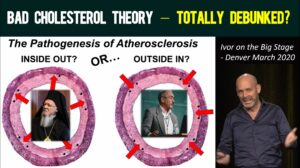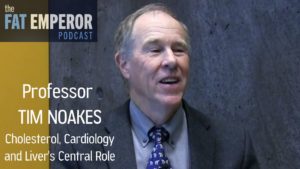The Study Background:
From the authors: “Some popular weight loss diets restricting carbohydrates (CHO) claim to be more effective, and have additional health benefits in preventing cardiovascular disease compared to balanced weight loss diets….”
My take: Another study that is highly selective of data in order to generate the desired output. In the face of mounting evidence that Low Carb is demonstrably more effective in delivering enhanced Appetite Control and associated ad libitum weight loss for the overweight and obese, along with reduced Visceral Adipose Tissue, improved Tot Chol/HDL-C ratio, improved Triglyceride/HDL-C ratio, lowered blood glucose and FBS, lowered Fasting Insulin, lowered HbA1c, lowered B.P., lowered GGT, lowered inflammation, and so on, some defenders of defunct science are becoming strident in producing flawed papers that obfuscate rather than enlighten . Back to the Low Carb advantages, enhanced appetite control is one of the most critical of the list, and is the factor that “raises all boats”, synergistically working with the core biochemistry to deliver the other positive metrics in a profound manner. Also, Trig:HDL ratio and Fasting Insulin are the key measures for the Obese and Insulin Resistant legions now occupying the planet.
So, for the Study in question, let’s take an engineering view:
Methods and Findings
EXHIBIT A: “We compared the effects of low CHO and isoenergetic balanced weight loss diets in overweight and obese adults assessed in randomised controlled trials (minimum follow-up of 12 weeks), and…..”
BAD ENGINEERING ALERT #1:
OK, so we haven’t passed the first sentence and already the study is heading down Meaningless Street to Irrelevance Square. One of the central technical points, a core tenet, almost the “sine qua non” pertaining to a low carb regime is the commensurate and wonderful appetite control that results – and the latter has been utterly eliminated from the study – rendering its conclusions largely worthless.
EXHIBIT B: “We evaluated dietary adherence and used GRADE to assess the quality of evidence. We calculated mean differences (MD) and performed random-effects meta-analysis….” Blah blah blah – much statistical analysis indeed, but all carried out on inappropriate raw material – the killer fatal flaw so common in many of these meta-analysis type efforts – you need engineering inference as well as the stat-play. In short, these guys never even looked at a true low carb diet – they generally selected ~40% carb regimes – garbage in, garbage out in other words. But……….they did have ONE apparently genuine low carb effort in there with the other 18 so-called “low-carb” studies included in their analysis – :
“Long-term effects of a low carbohydrate, low fat or high unsaturated fat diet compared to a no-intervention control”. This study by Lim et al actually attempted a real low carb option, and thus it’s the only one of the 19 worth assessing to be honest – let’s take a look under the hood, shall we?
BAD ENGINEERING ALERT #2:
Sadly, this study too is seriously compromised, and not just because of the isocalorific stipulation therein. Let’s glance at the adherence to the macronutrient regime over the study duration:

As we can see, the “low carb VLC” cohort fell apart after the first 3 months, going from 12.4% Carb to just under 40% by 15 months, rendering this, the only included study that had potential low carb relevance, pretty much defunct. The “high carb VLF” cohort in this one collapsed also, getting up to near 30% Fat (from 12.5% intended) after 15 months. What a mess. But surely we should see something of interest in the 3 month metrics at least, given that the participants kinda followed the intended regime for this long? Shall we take a peek? Do let’s:

As can be seen highlighted in green boxes, the Trigs and the master ratio of Trig:HDL, not to mention the master-master marker of Fasting Insulin, had a large beneficial movement with the VLC arm at three months, degrading thereafter as the study discipline essentially fell apart.
Note also that they used log transform for some key metrics (denoted by superscript “b”, which moderates the apparent changes observed – I won’t even bother converting back – later perhaps.
So, IN THE ONLY INCLUDED STUDY THAT TRULY REPRESENTS LOW CARB OUT OF 19 THEY AVERAGED, we could see the manifest benefits of VLC at 3 months, before they let it descend into farce after a few short months.
Remember that the rest of the studies they included in their analysis are largely useless because they are not true low carb, and the whole analysis is largely meaningless anyway because they forced the isocalorific restriction (and also they were very much restricted in calories throughout – around 1500 kCal per day, would never be sustained in real life situation, and would thus falsely advantage the low-fat regime………). For my pet marker Fasting Insulin (the “One Ring to Rule Them All” if you like your Tolkien), see below
Conclusions
This study appears to purposefully selecting inappropriate material to obfuscate the real issue of excessive carb ingestion in society today. Without the expertise needed to give it a proper critique, it appears to give strong evidence against the relative benefits of low carb; I am presuming that the study design was specifically tailored to achieve this goal, as it would be very unlikely to happen upon this degree of poor inference otherwise.







